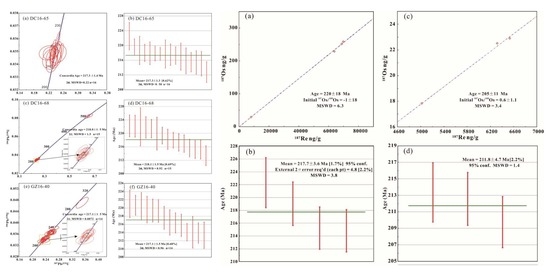Recognition of Late Triassic Cu-Mo Mineralization in the Northern Yidun Arc (S.E. Tibetan Plateau): Implications for Regional Exploration
Abstract
1. Introduction
2. Regional Geology
3. Sampling and Analytical Methods
3.1. Sampling and Sample Descriptions
3.2. LA-ICP-MS U-Pb Dating
3.3. ICP-MS Re-Os Dating
4. Results
4.1. Zircon U-Pb Ages
4.2. Molybdenite Re-Os Ages
5. Discussion
5.1. Timing of Magmatism and Cu-Mo Mineralization
5.2. Source of Ore-Forming Metals
5.3. Implication for Regional Exploration
6. Conclusions
Author Contributions
Funding
Acknowledgments
Conflicts of Interest
References
- Leng, C.B.; Huang, Q.Y.; Zhang, X.C.; Wang, S.X.; Zhong, H.; Hu, R.Z.; Bi, X.W.; Zhu, J.J.; Wang, X.S. Petrogenesis of the Late Triassic volcanic rocks in the Southern Yidun arc, SW China: Constraints from the geochronology, geochemistry, and Sr-Nd-Pb-Hf isotopes. Lithos 2014, 190, 363–382. [Google Scholar] [CrossRef]
- Reid, A.; Wilson, C.J.L.; Shun, L.; Pearson, N.; Belousova, E. Mesozoic plutons of the Yidun Arc, SW China: U/Pb geochronology and Hf isotopic signature. Ore Geol. Rev. 2007, 31, 88–106. [Google Scholar] [CrossRef]
- He, D.F.; Zhu, W.G.; Zhong, H.; Ren, T.; Bai, Z.J.; Fan, H.P. Zircon U-Pb geochronology and elemental and Sr-Nd-Hf isotopic geochemistry of the Daocheng granitic pluton from the Yidun Arc, SW China. J. Asian Earth Sci. 2013, 67, 1–17. [Google Scholar] [CrossRef]
- Li, W.C.; Yu, H.J.; Gao, X.; Liu, X.L.; Wang, J.H. Review of Mesozoic multiple magmatism and porphyry Cu-Mo (W) mineralization in the Yidun Arc, eastern Tibet Plateau. Ore Geol. Rev. 2017, 90, 795–812. [Google Scholar] [CrossRef]
- Gao, X.; Yang, L.Q.; Meng, J.Y.; Zhang, L.J. Zircon U-Pb, molybdenite Re-Os geochronology and Sr-Nd-Pb-Hf-O-S isotopic constraints on the genesis of Relin Cu-Mo deposit in Zhongdian, Northwest Yunnan, China. Ore Geol. Rev. 2017, 91, 945–962. [Google Scholar] [CrossRef]
- Leng, C.B.; Zhang, X.C.; Hu, R.Z.; Wang, S.X.; Zhong, H.; Wang, W.Q.; Bi, X.W. Zircon U-Pb and molybdenite Re-Os geochronology and Sr-Nd-Pb-Hf isotopic constraints on the genesis of the Xuejiping porphyry copper deposit in Zhongdian, Northwest Yunnan, China. J. Asian Earth Sci. 2012, 60, 31–48. [Google Scholar] [CrossRef]
- Li, W.C.; Yin, G.H.; Yu, H.J.; Lu, Y.X.; Liu, X.L. The porphyry metallogenesis of Geza volcanic magmatic arc in NW Yunnan. Acta Petrol. Sin. 2011, 27, 2541–2552, (In Chinese with English abstract). [Google Scholar]
- Li, W.C.; Yu, H.J.; Yin, G.H.; Cao, X.M.; Huang, D.Z.; Dong, T. Re-Os dating of molybdenite from Tongchanggou Mo-Polymetallic deposit in northwest Yunnan and its metallogenic environment. Miner. Depos. 2012, 31, 282–292, (In Chinese with English abstract). [Google Scholar]
- Peng, H.J.; Mao, J.W.; Pei, R.F.; Zhang, C.Q.; Tian, G.; Zhou, Y.M.; Li, J.X.; Hou, L. Geochronology of the Hongniu-Hongshan porphyry and skarn Cu deposit, northwestern Yunnan province, China: Implications for mineralization of the Zhongdian arc. J. Asian Earth Sci. 2014, 79, 682–695. [Google Scholar] [CrossRef]
- Yang, L.Q.; Gao, X.; Shu, Q.H. Multiple Mesozoic porphyry-Skarn Cu (Mo-W) systems in Yidun Terrane, east Tethys: Constraints from zircon U-Pb and molybdenite Re-Os geochronology. Ore Geol. Rev. 2017, 90, 813–826. [Google Scholar] [CrossRef]
- Zu, B.; Xue, C.J.; Zhao, Y.; Qu, W.J.; Li, C.; Symons, D.T.A.; Du, A.D. Late Cretaceous metallogeny in the Zhongdian area: Constraints from Re-Os dating of molybdenite and pyrrhotite from the Hongshan Cu deposit, Yunnan, China. Ore Geol. Rev. 2015, 64, 1–12. [Google Scholar] [CrossRef]
- Li, W.C.; Zeng, P.S.; Hou, Z.Q.; White, N.C. The Pulang Porphyry Copper Deposit and Associated Felsic Intrusions in Yunnan Province, Southwest China. Econ. Geol. 2011, 106, 79–92. [Google Scholar]
- Zeng, P.S.; Li, W.C.; Wang, H.P.; Li, H. The Indosinian Pulang superlarge porphyry copper deposit in Yunnan, China: Petrology and chronology. Acta Petrol. Sin. 2006, 22, 989–1000, (In Chinese with English abstract). [Google Scholar]
- Wang, X.S.; Bi, X.W.; Leng, C.B.; Zhong, H.; Tang, H.F.; Chen, Y.W.; Yin, G.H.; Huang, D.Z.; Zhou, M.F. Geochronology and geochemistry of Late Cretaceous igneous intrusions and Mo-Cu-(W) mineralization in the southern Yidun Arc, SW China: Implications for metallogenesis and geodynamic setting. Ore Geol. Rev. 2014, 61, 73–95. [Google Scholar] [CrossRef]
- Wang, X.S.; Hu, R.Z.; Bi, X.W.; Leng, C.B.; Pan, L.C.; Zhu, J.J.; Chen, Y.W. Petrogenesis of Late Cretaceous I-Type granites in the southern Yidun Terrane: New constraints on the Late Mesozoic tectonic evolution of the eastern Tibetan Plateau. Lithos 2014, 208, 202–219. [Google Scholar] [CrossRef]
- Chen, X.; Li, Y.G.; Xu, M.; Reng, G.M. Geology and ore genesis of Zhujiding porphyry copper in western. Sichuan Province. Geol. Prospect. 2008, 44, 42–45, (In Chinese with English abstract). [Google Scholar]
- Deng, H.B. Geological features of the Zhujiding porphyry copper deposit in Daocheng, Sichuan. Acta Geol. Sichuan. 2008, 28, 105–108, (In Chinese with English abstract). [Google Scholar]
- Li, X.Y.; Zhang, J.R.; Song, H.; Lai, C.K. Copper mineralization potential of Late Triassic granitoids in Northern Yidun Arc, SW China. Minerals 2019, 9, 337. [Google Scholar] [CrossRef]
- Mao, J.W.; Zhang, Z.C.; Zhang, Z.H.; Du, A.D. Re-Os isotopic dating of molybdenites in the Xiaoliugou W (Mo) deposit in the northern Qilian mountains and its geological significance. Geochim. Cosmochim. Acta 1999, 63, 1815–1818. [Google Scholar]
- Stein, H.J.; Markey, R.J.; Morgan, J.W.; Du, A.D.; Sun, Y.L. Highly precise and accurate Re-Os ages for molybdenite from the East Qinling molybdenum belt, Shanxi Province, China. Econ. Geol. 1997, 92, 827–835. [Google Scholar] [CrossRef]
- Stein, H.J.; Markey, R.J.; Morgan, J.W.; Hannah, J.L.; Schersten, A. The remarkable Re-Os chronometer in molybdenite: How and why it works. Terra Nova 2001, 13, 479–486. [Google Scholar] [CrossRef]
- Reid, A.J.; Wilson, C.J.L.; Liu, S. Structural evidence for the Permo-Triassic tectonic evolution of the Yidun Arc, eastern Tibetan Plateau. J. Struct. Geol. 2005, 27, 119–137. [Google Scholar] [CrossRef]
- BGMRSP (Bureau of Geology and Mineral Resources of Sichuan Province). Regional Geology of the Sichuan Province; Geological Publishing House: Beijing, China, 1991; pp. 1–730, (In Chinese with English abstract).
- Hou, Z.Q.; Hou, L.W.; Ye, Q.T.; Liu, F.L.; Tang, G.G. Tectono-Magmatic Evolution and Volcanogenic Massive Sulphide Deposits in the Yidun Island-Arc, Sanjiang Region, China; Earthquake Publishing House: Beijing, China, 1995; pp. 1–218, (In Chinese with English abstract). [Google Scholar]
- Chang, E.Z. Geology and tectonics of the Songpan-Ganzi fold belt, southwestern China. Int. Geol. Rev. 2000, 42, 813–831. [Google Scholar] [CrossRef]
- Song, X.Y.; Zhou, M.F.; Cao, Z.M.; Robinson, P.T. Late Permian rifting of the South China Craton caused by the Emeishan mantle plume. J. Geol. Soc. 2004, 161, 773–781. [Google Scholar] [CrossRef]
- Tian, Z.D.; Leng, C.B.; Zhang, X.C.; Yin, C.J.; Zhang, W.; Guo, J.H.; Tian, F. Mineralogical characteristics of chlorites from Precambrian metamorphic rocks in Yidun magmatic arc of Qinghai-Tibet Plateau and their geological implications. J. Earth Sci. Env. 2018, 40, 36–48, (In Chinese with English abstract). [Google Scholar]
- Tian, Z.D.; Leng, C.B.; Zhang, X.C.; Yin, C.J.; Zhang, W.; Guo, J.H.; Chen, L.H. Mineralogical and petrogeochemical characteristics of the metamorphic basement of Yidun Terrane and their geological implications. Acta Mineral. Sin. 2018, 38, 152–165, (In Chinese with English abstract). [Google Scholar]
- Wang, B.Q.; Wang, W.; Zhou, M.F. Provenance and tectonic setting of the Triassic Yidun Group, the Yidun Terrane, Tibet. Geosci. Front. 2013, 4, 765–777. [Google Scholar] [CrossRef][Green Version]
- Wang, B.Q.; Zhou, M.F.; Chen, W.T.; Gao, J.F.; Yan, D.P. Petrogenesis and tectonic implications of the Triassic volcanic rocks in the northern Yidun Terrane, Eastern Tibet. Lithos 2013, 175, 285–301. [Google Scholar] [CrossRef]
- Hou, Z.Q.; Qu, X.M.; Zhou, J.R.; Yang, Y.Q.; Huang, D.H.; Lv, Q.T.; Tang, S.H.; Yu, J.J.; Wang, H.P.; Zhao, J.H. Collision-Orogenic processes of the Yidun arc in the Sanjiang region: Record of granites. Acta Geol. Sin. 2001, 75, 484–497, (In Chinese with English abstract). [Google Scholar]
- Wu, T.; Xiao, L.; Wilde, S.A.; Ma, C.Q.; Zhou, J.X. A mixed source for the Late Triassic Garze-Daocheng granitic belt and its implications for the tectonic evolution of the Yidun arc belt, eastern Tibetan Plateau. Lithos 2017, 288, 214–230. [Google Scholar] [CrossRef]
- Chen, J.L.; Xu, J.F.; Ren, J.B.; Huang, X.X.; Wang, B.D. Geochronology and geochemical characteristics of Late Triassic porphyritic rocks from the Zhongdian arc, eastern Tibet, and their tectonic and metallogenic implications. Gondwana Res. 2014, 26, 492–504. [Google Scholar] [CrossRef]
- Li, J.K.; Li, W.C.; Wang, D.H.; Lu, Y.X.; Yin, G.H.; Xue, S.R. Re-Os dating for ore-Forming event in the late of Yanshan epoch and research of ore-Forming regularity in Zhongdian Arc. Acta Petrol. Sin. 2007, 23, 2415–2422, (In Chinese with English abstract). [Google Scholar]
- Chen, W.S.; Zheng, S.Q.; Li, S.L.; Wen, P.R.; Zheng, Y.M. 1:200,000 Geological Map of Daocheng, Sichuan Province; Bureau of Geology, Sichuan: Chengdu, China, 1984.
- Gao, Y.T.; Jia, Z.Q.; Li, X.Z.; Wen, P.R.; Mao, J.Y. 1:200,000 Geological Map of Ganze, Sichuan Province; Bureau of Geology, Sichuan: Chengdu, China, 1980.
- Wiedenbeck, M.; Alle, P.; Corfu, F.; Griffin, W.; Meier, M.; Oberli, F.; Quadt, A.; Roddick, J.C.; Spiegel, W. Three natural zircon standards for U-Th-Pb, Lu-Hf, trace element and REE analyses. Geostand. Newsl. 1995, 19, 1–23. [Google Scholar] [CrossRef]
- Jackson, S.E.; Pearson, N.J.; Griffin, W.L.; Belousova, E.A. The application of laser ablation-Inductively coupled plasma-Mass spectrometry to in situ U–Pb zircon geochronology. Chem. Geol. 2004, 211, 47–69. [Google Scholar] [CrossRef]
- Slama, J.; Kosler, J.; Condon, D.J.; Crowley, J.L.; Gerdes, A.; Hanchar, J.M.; Horstwood, M.S.A.; Morris, G.A.; Nasdala, L.; Norberg, N.; et al. Plesovice zircon-A new natural reference material for U–Pb and Hf isotopic microanalysis. Chem. Geol. 2008, 249, 1–35. [Google Scholar] [CrossRef]
- Liu, Y.S.; Gao, S.; Hu, Z.C.; Gao, C.G.; Zong, K.Q.; Wang, D.B. Continental and oceanic crust recycling-Induced melt-Peridotite interactions in the Trans-North China Orogen: U-Pb dating, Hf isotopes and trace elements in zircons from mantle xenoliths. J. Petrol. 2010, 51, 537–571. [Google Scholar] [CrossRef]
- Liu, Y.S.; Hu, Z.C.; Gao, S.; Gunther, D.; Xu, J.; Gao, C.G.; Chen, H.H. In situ analysis of major and trace elements of anhydrous minerals by LA-ICP-MS without applying an internal standard. Chem. Geol. 2008, 257, 34–43. [Google Scholar] [CrossRef]
- Ludwig, K.R. User’s Manual for Isoplot 3.00, a Geochronological Toolkit for Microsoft Excel; Berkeley Geochronology Center Special Publication: Berkeley, CA, USA, 2003; pp. 25–32. [Google Scholar]
- Du, A.D.; Wu, S.Q.; Sun, D.Z.; Wang, S.X.; Qu, W.J.; Markey, R.; Stain, H.; Morgan, J.; Malinovskiy, D. Preparation and certification of Re-Os dating reference materials: Molybdenites HLP and JDC. Geostand. Geoanal. Res. 2004, 28, 41–52. [Google Scholar] [CrossRef]
- Shirey, S.B.; Walker, R.J. Carius tube digestion for low-Blank rhenium-Osmium analysis. Anal. Chem. 1995, 67, 2136–2141. [Google Scholar] [CrossRef]
- Smoliar, M.I.; Walker, R.J.; Morgan, J.W. Re-Os ages of group IIA, IIIA, IVA, and IVB iron meteorites. Science 1996, 271, 1099–1102. [Google Scholar] [CrossRef]
- Corfu, F.; Hanchar, J.M.; Hoskin, P.W.O.; Kinny, P. Atlas of zircon textures. Rev. Mineral. Geochem. 2003, 53, 469–500. [Google Scholar] [CrossRef]
- Hanchar, J.M.; Rudnick, R.L. Revealing hidden structures: The application of cathodoluminescence and back-scattered electron imaging to dating zircons from lower crustal xenoliths. Lithos 1995, 36, 289–303. [Google Scholar] [CrossRef]
- Wu, Y.B.; Zheng, Y.F. Genesis of zircon and its constraints on interpretation of U-Pb age. Chin. Sci. Bull. 2004, 49, 1554–1569. [Google Scholar] [CrossRef]
- Weislogel, A.L. Tectonostratigraphic and geochronologic constraints on evolution of the northeast Paleotethys from the Songpan-Ganzi complex, central China. Tectonophysics 2008, 451, 331–345. [Google Scholar] [CrossRef]
- Berzina, A.N.; Sotnikov, V.I.; Economou-Eliopoulos, M.; Eliopoulos, D.G. Distribution of rhenium in molybdenite from porphyry Cu–Mo and Mo–Cu deposits of Russia (Siberia) and Mongolia. Ore Geol. Rev. 2005, 26, 91–113. [Google Scholar] [CrossRef]
- Yang, L.Q.; Deng, J.; Gao, X.; He, W.Y.; Meng, J.Y.; Santosh, M.; Yu, H.J.; Yang, Z.; Wang, D. Timing of formation and origin of the Tongchanggou porphyry-Skarn deposit: Implications for Late Cretaceous Mo-Cu metallogenesis in the southern Yidun Terrane, SE Tibetan Plateau. Ore Geol. Rev. 2017, 81, 1015–1032. [Google Scholar] [CrossRef]
- Zeng, Y.F. The Geological Characteristics and Discussions on the Geneis of Porphyry Copper Deposit in Changdagou. Master’s Thesis, Chengdu University of Technology, Chengdu, China, 2015. [Google Scholar]
- Kong, D.X.; Xu, J.F.; Chen, J.L. Oxygen isotope and trace element geochemistry of zircons from porphyry copper system: Implications for Late Triassic metallogenesis within the Yidun Terrane, southeastern Tibetan Plateau. Chem. Geol. 2016, 441, 148–161. [Google Scholar] [CrossRef]
- Wang, B.Q.; Zhou, M.F.; Li, J.W.; Yan, D.P. Late Triassic porphyritic intrusions and associated volcanic rocks from the Shangri-La region, Yidun terrane, Eastern Tibetan Plateau: Adakitic magmatism and porphyry copper mineralization. Lithos 2011, 127, 24–38. [Google Scholar] [CrossRef]
- Leng, C.B.; Gao, J.F.; Chen, W.T.; Zhang, X.C.; Tian, Z.D.; Guo, J.H. Platinum-Group elements, zircon Hf-O isotopes, and mineralogical constraints on magmatic evolution of the Pulang porphyry Cu-Au system, SW China. Gondwana Res. 2018, 62, 163–177. [Google Scholar] [CrossRef]
- Cao, K.; Xu, J.F.; Chen, J.L.; Huang, X.X.; Ren, J.B.; Zhao, X.D.; Liu, Z.X. Double-Layer structure of the crust beneath the Zhongdian arc, SW China: U–Pb geochronology and Hf isotope evidence. J. Asian Earth Sci. 2016, 115, 455–467. [Google Scholar] [CrossRef]
- Yang, F.; Zou, G.F.; Wu, J.; Li, F.; Jiang, Y.G.; Zhao, X.D. Ages and geological significance of the porphyries in the Chundu copper mining area in Zhongdian, Yunnan Province. Geotecton. Metallog. 2011, 35, 314–317, (In Chinese with English abstract). [Google Scholar]
- Ren, J.B.; Xu, J.F.; Chen, J.L. Zircon geochronology and geological implications of ore-Bearing porphyries fromZhongdian arc. Acta Petrol. Sin. 2011, 27, 2591–2599, (In Chinese with English abstract). [Google Scholar]
- Cao, D.H.; Wang, A.J.; Huang, Y.F.; Zhang, W.; Hou, K.J.; Li, R.P.; Li, Y.K. SHRIMP geochronology and Hf isotope composition of zircons from Xuejiping porphyry copper deposit, Yunnan Province. Acta Geol. Sin. 2009, 83, 1430–1435, (In Chinese with English abstract). [Google Scholar]
- Wang, X.S.; Bi, X.W.; Leng, C.B.; Tang, Y.Y.; Lan, J.B.; Qi, Y.Q.; Shen, N.P. LA-ICP-MS zircon U-Pb dating of granite porphyry in the Hongshan Cu-Polymetallic deposit, Zhongdian, northwest Yunnan, China and its geological implication. Acta Mineral. Sin. 2011, 31, 315–321, (In Chinese with English abstract). [Google Scholar]
- Huang, X.X.; Xu, J.F.; Chen, J.L.; Ren, J.B. Geochronology, geochemistry, and petrogenesis of two periods of intermediate-Acid intrusive rocks from Hongshan area in Zhongdian arc. Acta Petrol. Sin. 2012, 28, 1493–1506, (In Chinese with English abstract). [Google Scholar]
- Xu, X.W.; Cai, X.P.; Qu, W.J.; Song, B.C.; Qin, K.Z.; Zhang, B.L. Late Cretaceous granite porphyritic Cu-Mo mineralization system in the Hongshan area, Northwestern Yunnan and its significances for tectonics. Acta Geol. Sin. 2006, 80, 1422–1433, (In Chinese with English abstract). [Google Scholar]
- Meng, J.Y.; Yang, L.Q.; Lu, L.; Gao, X.; Li, J.X.; Luo, Y.Z. Re-Os dating of molybdenite from the Hongshan Cu-Mo deposit in Northwest Yunnan and its implications for mineralization. Acta Petrol. Sin. 2013, 29, 1214–1222, (In Chinese with English abstract). [Google Scholar]
- Meinert, L.D.; Dipple, G.M.; Nicolescu, S. World Skarn Deposits. Econ. Geol. 2005, 1905–2005, 299–336. [Google Scholar]
- Wan, B.; Xiao, W.J.; Han, C.M.; Windley, B.F.; Zhang, L.C.; Qu, W.J.; Du, A.D. Re–Os molybdenite age of the Cu–Mo skarn ore deposit at Suoerkuduke in East Junggar, NW China and its geological significance. Ore Geol. Rev. 2014, 56, 541–548. [Google Scholar] [CrossRef]
- Fei, G.C.; Li, Y.G. Geological features and mineragenic potentiality of granite aplite in Zhujiding copper deposit in Sichuan Province. Xinjiang Geol. 2010, 28, 204–208, (In Chinese with English abstract). [Google Scholar]
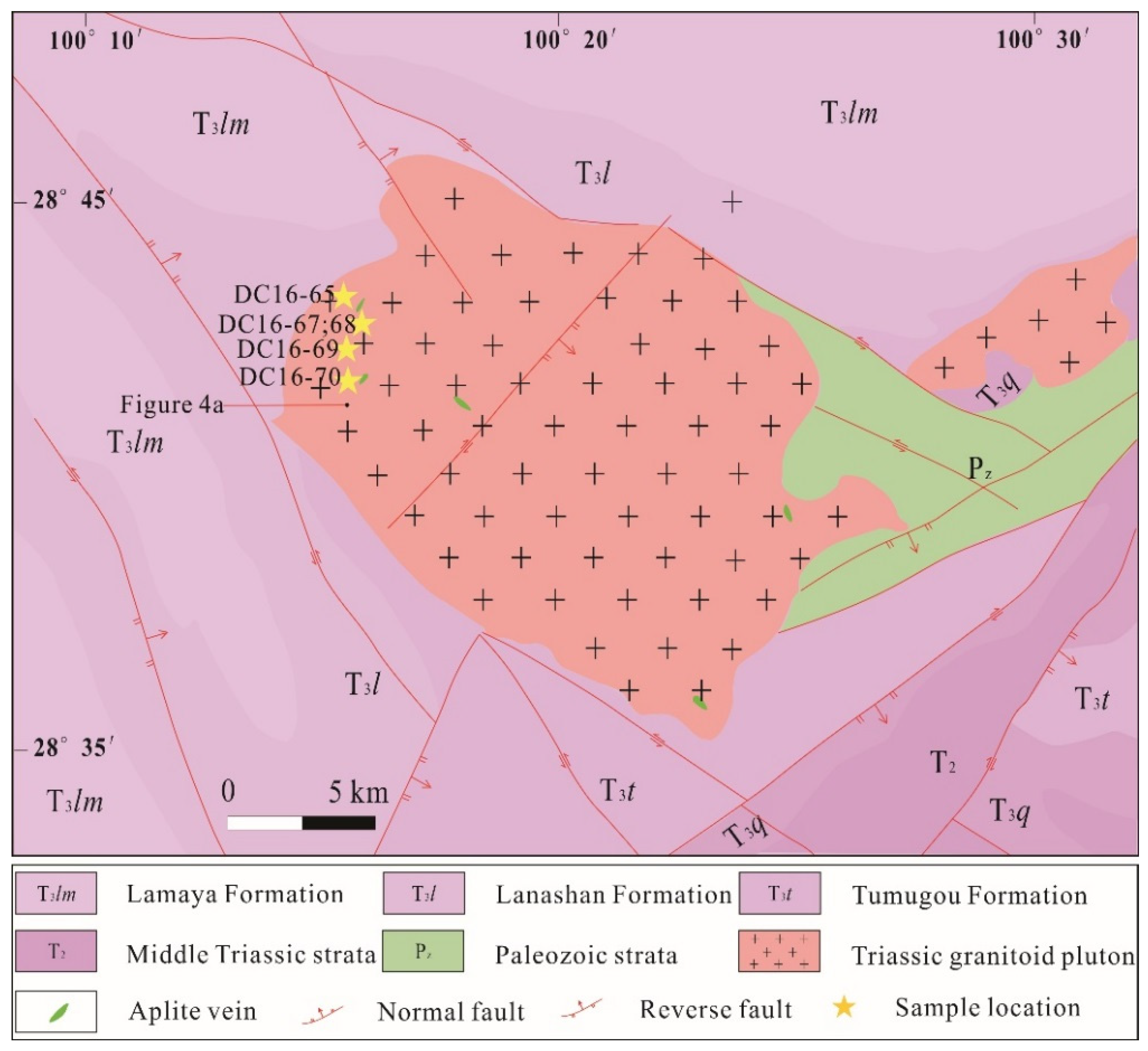
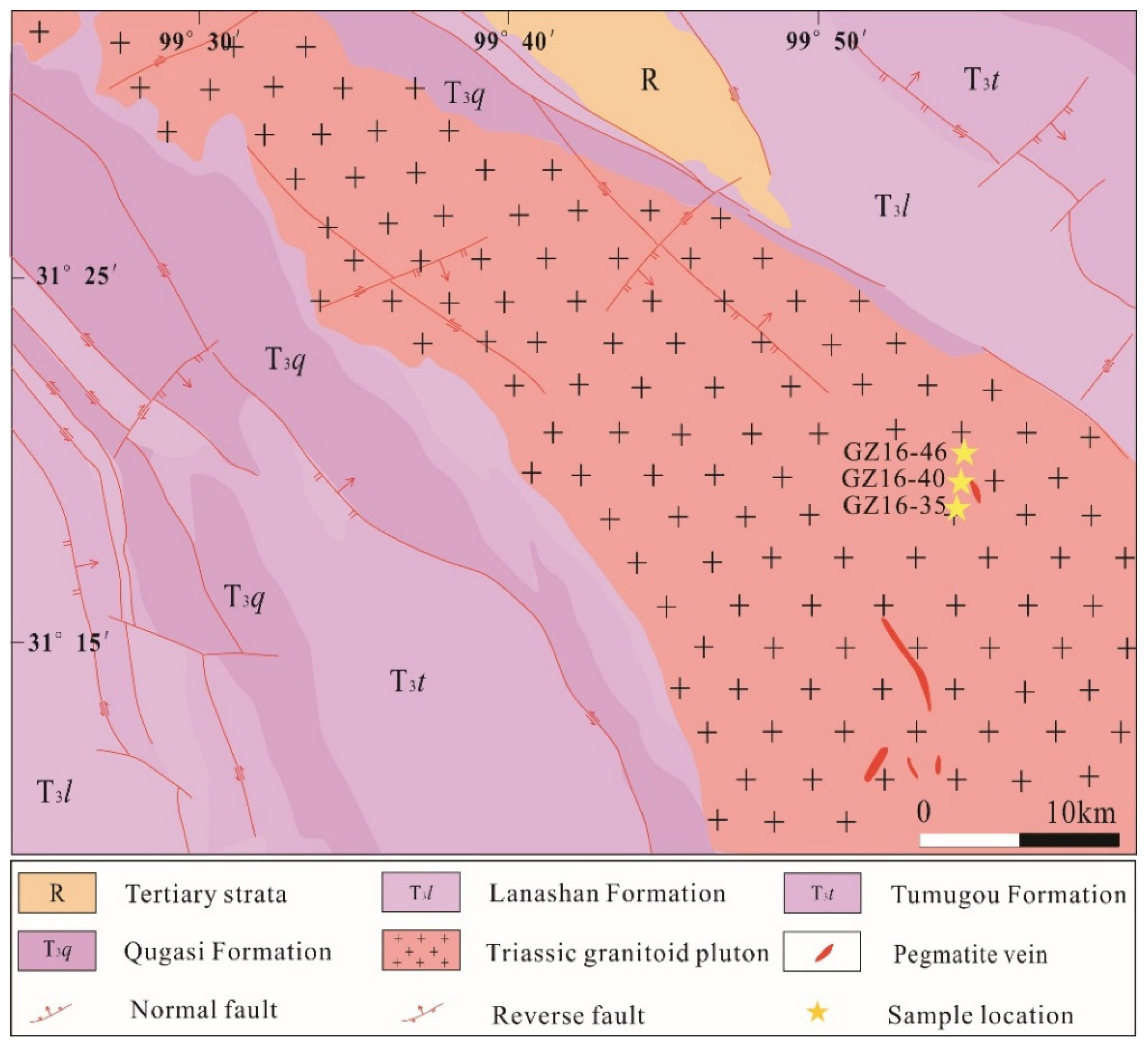
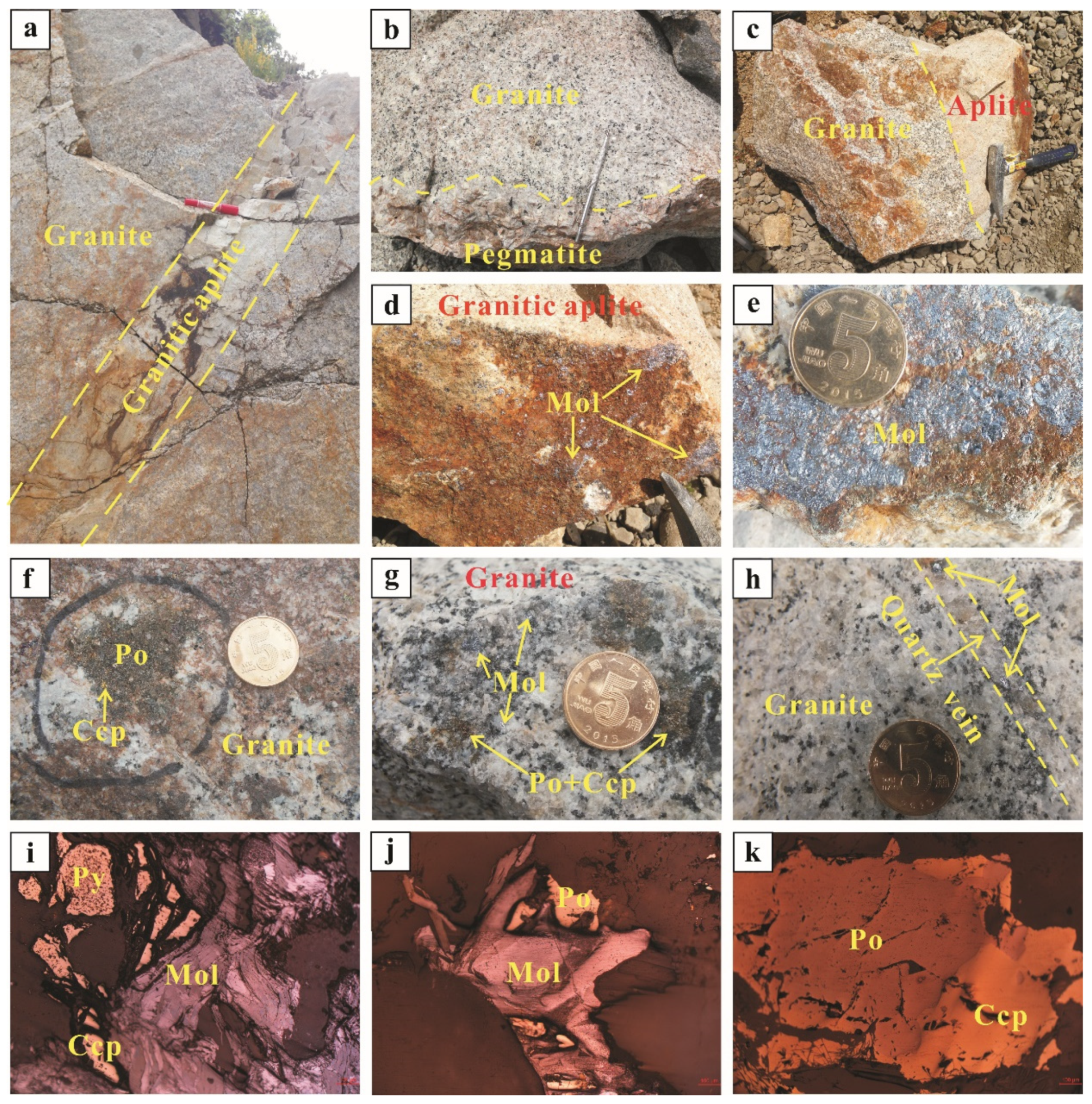
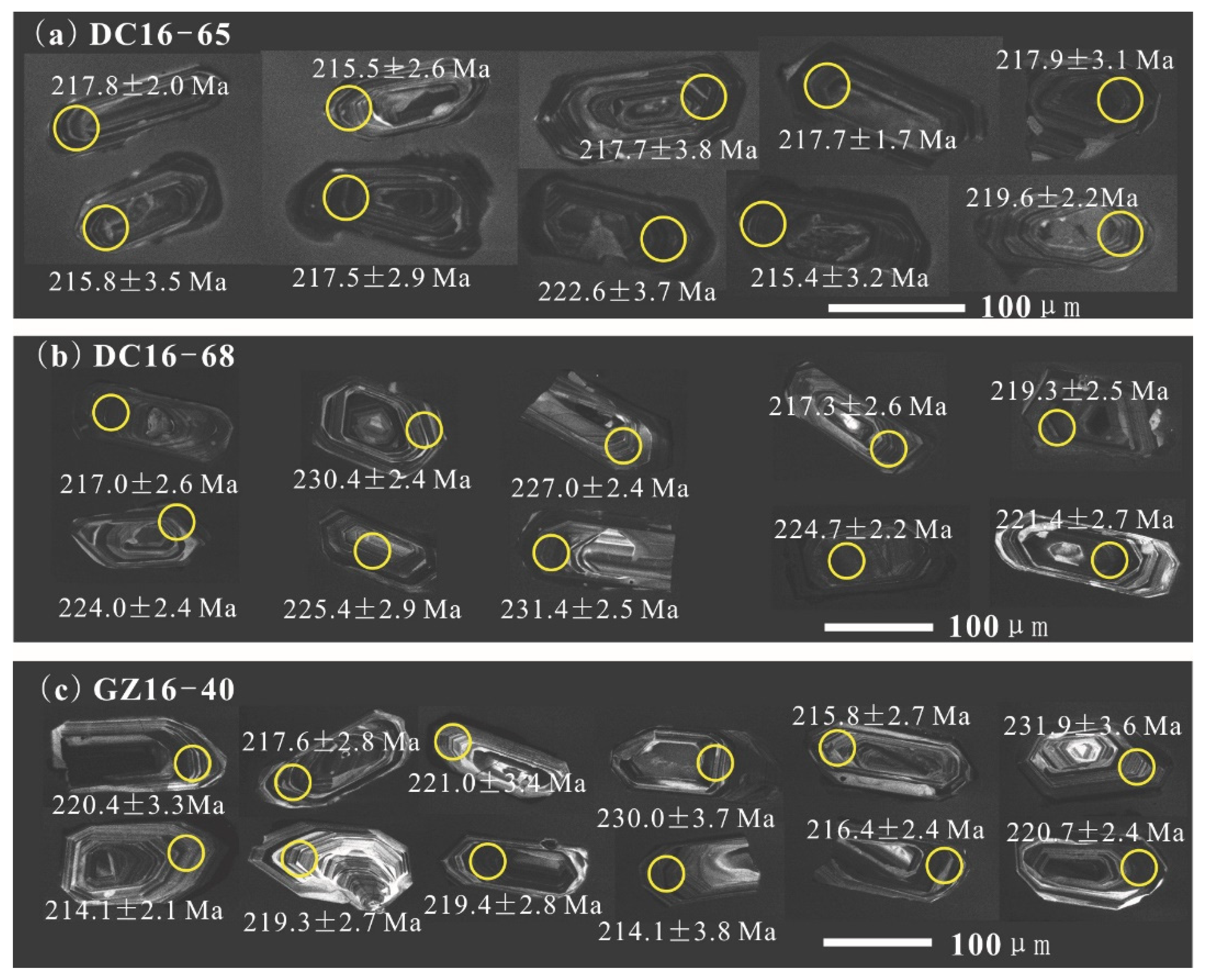
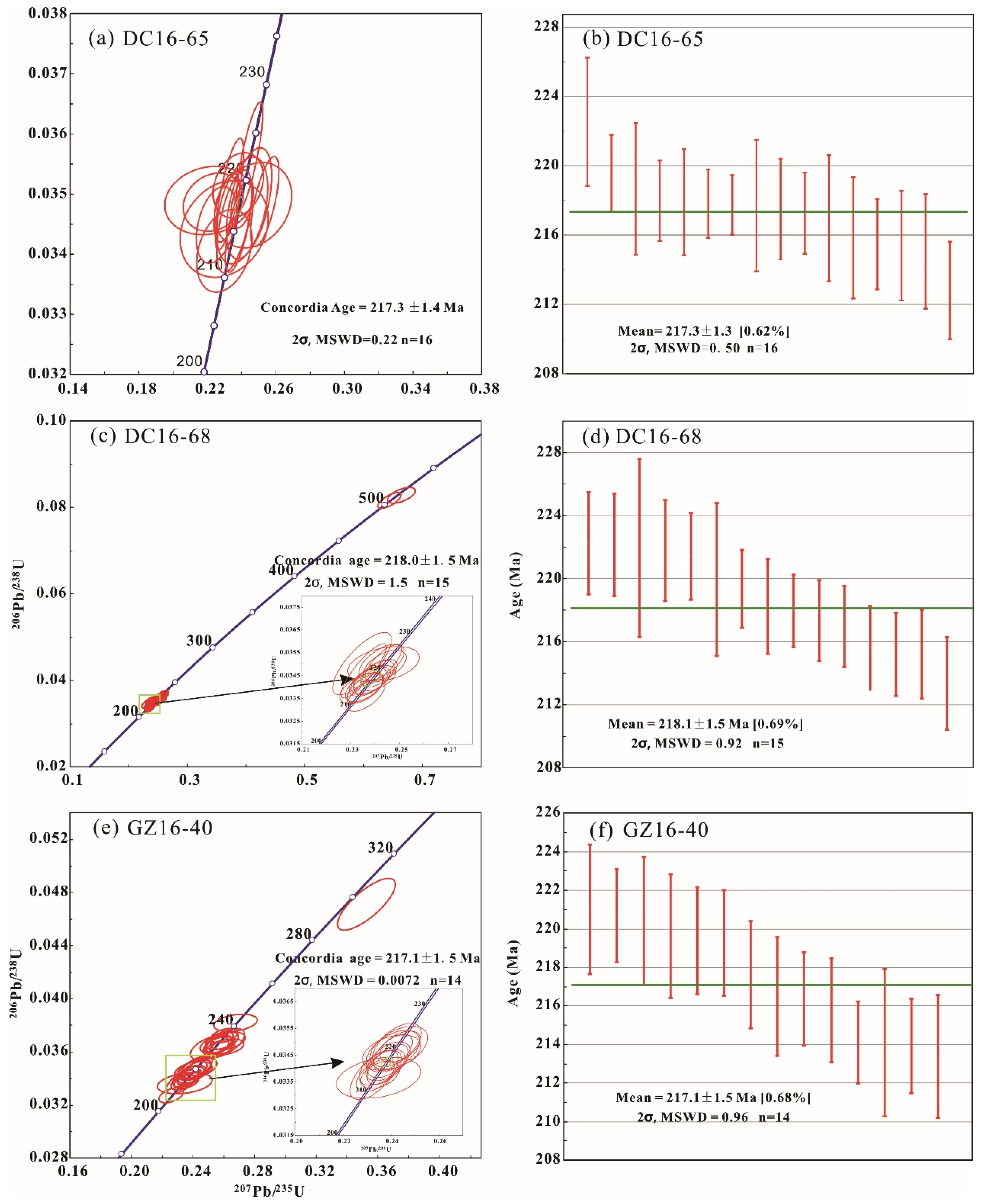
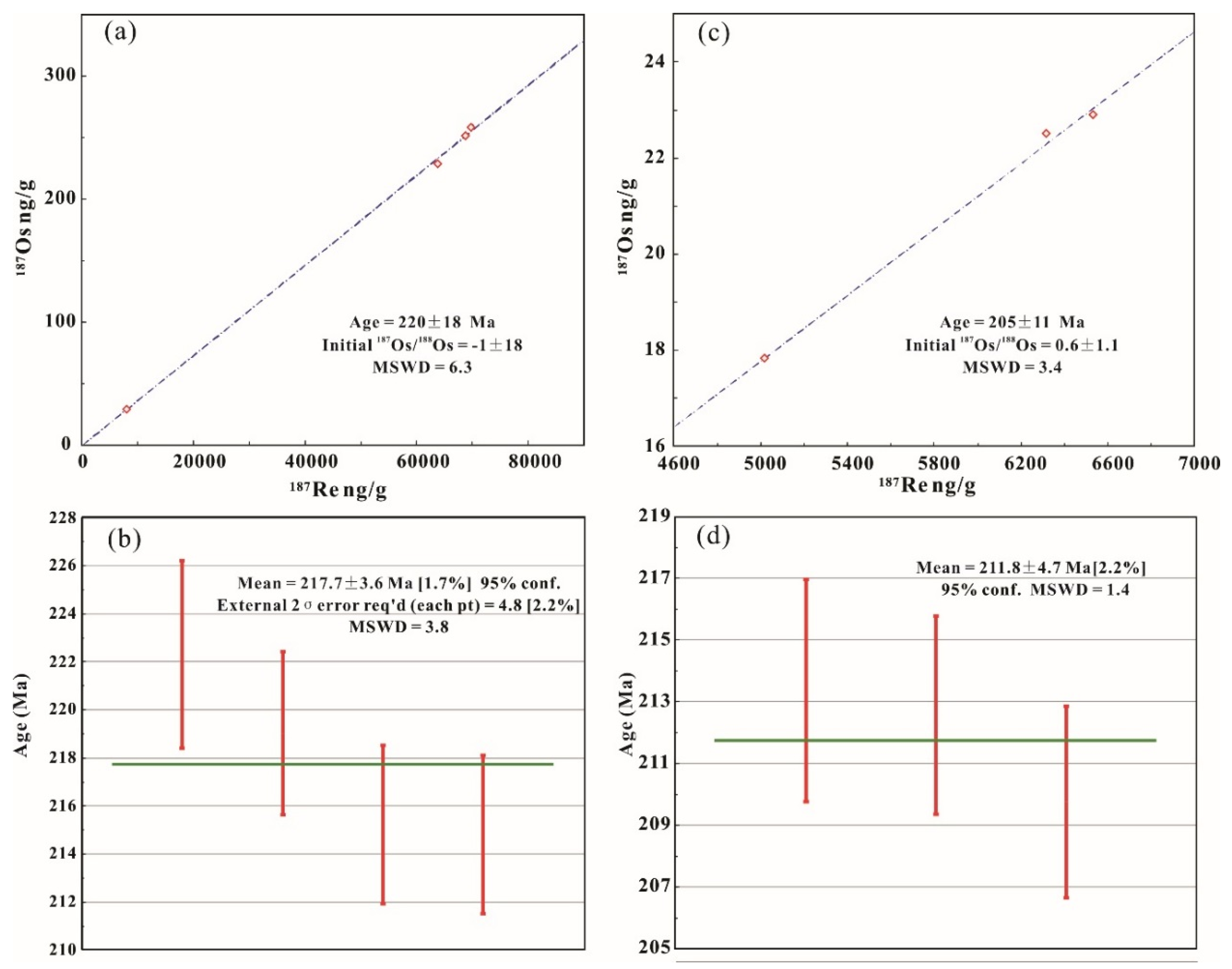
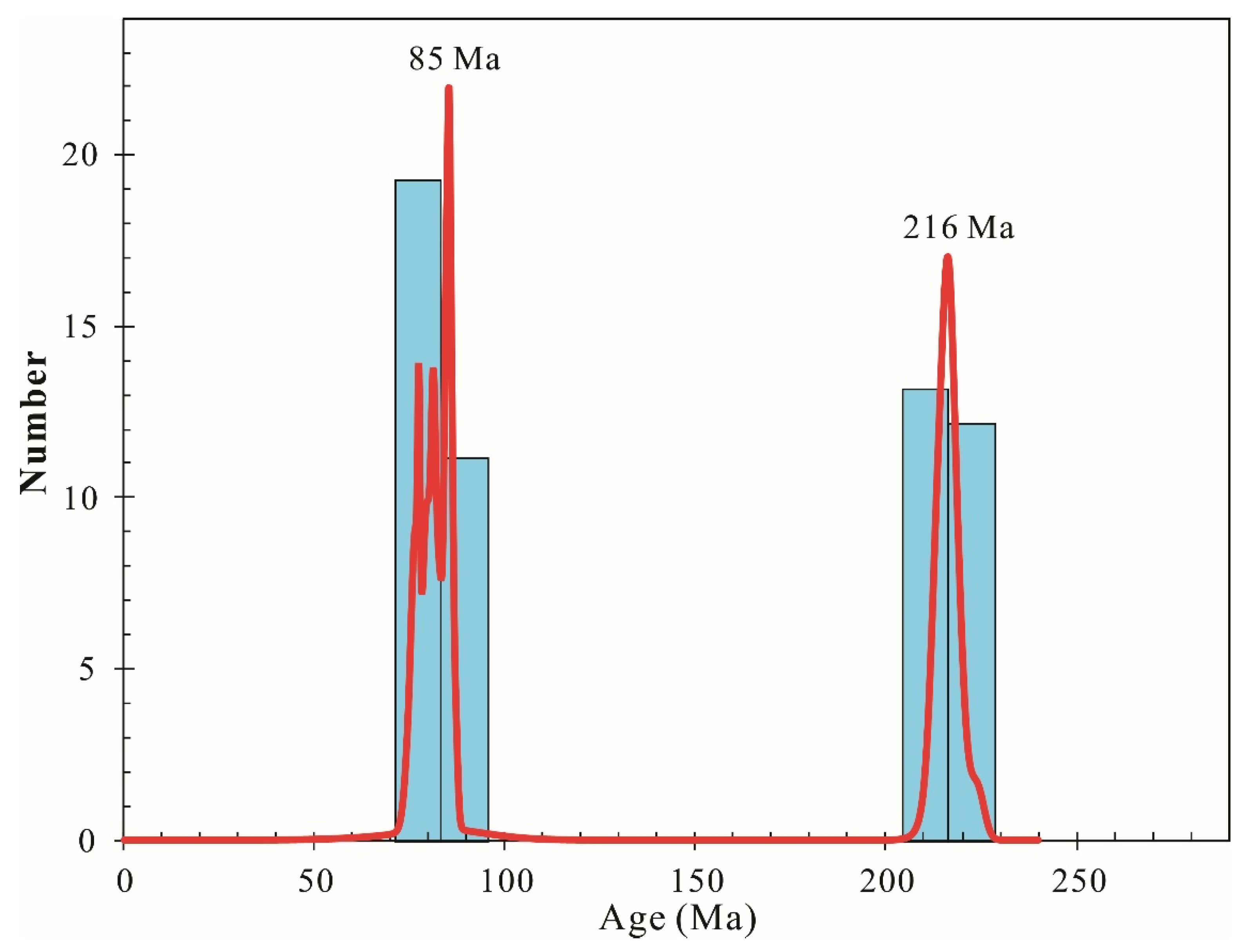
| No. | Th (ppm) | U (ppm) | Th/U | 207Pb/206Pb | 207Pb/235U | 206Pb/238U | 207Pb/206Pb | 207Pb/235U | 206Pb/238U | Concordance | ||||||
|---|---|---|---|---|---|---|---|---|---|---|---|---|---|---|---|---|
| Ratio | 1sigma | Ratio | 1sigma | Ratio | 1sigma | Age (Ma) | 1sigma | Age (Ma) | 1sigma | Age (Ma) | 1sigma | |||||
| 91500 | ||||||||||||||||
| 1 | 36.6 | 104 | 0.35 | 0.0754 | 0.0019 | 1.8571 | 0.0449 | 0.1789 | 0.0020 | 1080 | 48.2 | 1066 | 16.0 | 1061 | 10.9 | 99% |
| 2 | 35.3 | 101 | 0.35 | 0.0743 | 0.0020 | 1.8433 | 0.0514 | 0.1795 | 0.0022 | 1050 | 55.6 | 1061 | 18.4 | 1064 | 12.2 | 99% |
| 3 | 33.9 | 96.8 | 0.35 | 0.0751 | 0.0020 | 1.8524 | 0.0515 | 0.1791 | 0.0021 | 1072 | 53.7 | 1064 | 18.4 | 1062 | 11.4 | 99% |
| 4 | 34.6 | 97.9 | 0.35 | 0.0746 | 0.0019 | 1.8480 | 0.0529 | 0.1792 | 0.0022 | 1059 | 51.4 | 1063 | 18.9 | 1063 | 11.9 | 99% |
| 5 | 34.9 | 99.4 | 0.35 | 0.0750 | 0.0021 | 1.8568 | 0.0500 | 0.1795 | 0.0023 | 1133 | 56.6 | 1066 | 17.8 | 1064 | 12.5 | 99% |
| 6 | 34.8 | 99.1 | 0.35 | 0.0748 | 0.0020 | 1.8436 | 0.0485 | 0.1788 | 0.0027 | 1061 | 52.6 | 1061 | 17.3 | 1061 | 15.0 | 99% |
| 7 | 25.3 | 71.0 | 0.36 | 0.0751 | 0.0020 | 1.8583 | 0.0528 | 0.1793 | 0.0022 | 1072 | 53.7 | 1066 | 18.8 | 1063 | 12.1 | 99% |
| 8 | 24.8 | 71.3 | 0.35 | 0.0746 | 0.0024 | 1.8421 | 0.0650 | 0.1791 | 0.0024 | 1058 | 63.0 | 1061 | 23.2 | 1062 | 13.1 | 99% |
| 9 | 25.8 | 74.6 | 0.35 | 0.0756 | 0.0018 | 1.8642 | 0.0435 | 0.1791 | 0.0022 | 1084 | 47.4 | 1068 | 15.5 | 1062 | 12.2 | 99% |
| 10 | 26.9 | 75.9 | 0.35 | 0.0742 | 0.0018 | 1.8362 | 0.0472 | 0.1792 | 0.0021 | 1056 | 49.2 | 1059 | 16.9 | 1063 | 11.7 | 99% |
| 11 | 25.8 | 74.0 | 0.35 | 0.0734 | 0.0019 | 1.8130 | 0.0441 | 0.1792 | 0.0023 | 1025 | 52.3 | 1050 | 15.9 | 1063 | 12.5 | 98% |
| 12 | 26.0 | 73.9 | 0.35 | 0.0764 | 0.0019 | 1.8874 | 0.0490 | 0.1791 | 0.0023 | 1106 | 50.0 | 1077 | 17.3 | 1062 | 12.8 | 98% |
| 13 | 26.3 | 75.1 | 0.35 | 0.0764 | 0.0019 | 1.8459 | 0.0556 | 0.1787 | 0.0023 | 1106 | 49.5 | 1062 | 19.8 | 1060 | 12.5 | 99% |
| 14 | 26.8 | 75.5 | 0.35 | 0.0734 | 0.0020 | 1.8545 | 0.0759 | 0.1796 | 0.0022 | 1025 | 56.0 | 1065 | 27.0 | 1065 | 12.0 | 99% |
| 15 | 20.2 | 56.9 | 0.36 | 0.0754 | 0.0026 | 1.8472 | 0.0654 | 0.1780 | 0.0026 | 1080 | 69 | 1062 | 23.3 | 1056 | 14.5 | 99% |
| 16 | 19.7 | 56.7 | 0.35 | 0.0743 | 0.0025 | 1.8532 | 0.0610 | 0.1804 | 0.0029 | 1050 | 68 | 1065 | 21.7 | 1069 | 15.6 | 99% |
| 17 | 19.7 | 56.4 | 0.35 | 0.0756 | 0.0022 | 1.8655 | 0.0544 | 0.1792 | 0.0027 | 1087 | 57 | 1069 | 19.3 | 1063 | 15.0 | 99% |
| 18 | 19.0 | 55.6 | 0.34 | 0.0741 | 0.0021 | 1.8349 | 0.0552 | 0.1791 | 0.0028 | 1056 | 56 | 1058 | 19.8 | 1062 | 15.2 | 99% |
| 19 | 19.1 | 55.2 | 0.35 | 0.0755 | 0.0022 | 1.8688 | 0.0580 | 0.1791 | 0.0027 | 1081 | 59 | 1070 | 20.6 | 1062 | 14.7 | 99% |
| 20 | 18.8 | 54.5 | 0.34 | 0.0743 | 0.0025 | 1.8316 | 0.0592 | 0.1792 | 0.0027 | 1050 | 68 | 1057 | 21.3 | 1063 | 14.5 | 99% |
| 21 | 17.3 | 49.8 | 0.35 | 0.0746 | 0.0023 | 1.8482 | 0.0605 | 0.1790 | 0.0025 | 1057 | 63 | 1063 | 21.6 | 1062 | 13.9 | 99% |
| 22 | 16.9 | 48.9 | 0.35 | 0.0752 | 0.0025 | 1.8522 | 0.0607 | 0.1793 | 0.0025 | 1072 | 68 | 1064 | 21.6 | 1063 | 13.9 | 99% |
| GJ-1 | ||||||||||||||||
| 1 | 7.03 | 394 | 0.02 | 0.0573 | 0.0014 | 0.7775 | 0.0178 | 0.0983 | 0.0012 | 506 | 58 | 584 | 10.2 | 605 | 7.0 | 96% |
| 2 | 11.5 | 639 | 0.02 | 0.0586 | 0.0012 | 0.7882 | 0.0170 | 0.0977 | 0.0012 | 554 | 42.6 | 590 | 9.7 | 601 | 6.9 | 98% |
| 3 | 12.4 | 676 | 0.02 | 0.0617 | 0.0012 | 0.8195 | 0.0169 | 0.0961 | 0.0011 | 665 | 42.6 | 608 | 9.5 | 592 | 6.4 | 97% |
| 4 | 7.09 | 399 | 0.02 | 0.0622 | 0.0013 | 0.8441 | 0.0192 | 0.0981 | 0.0013 | 683 | 42.6 | 621 | 10.6 | 603 | 7.9 | 97% |
| 5 | 6.76 | 381 | 0.02 | 0.0608 | 0.0010 | 0.8173 | 0.0136 | 0.0975 | 0.0008 | 632 | 34.4 | 607 | 7.6 | 600 | 4.9 | 98% |
| 6 | 6.97 | 395 | 0.02 | 0.0591 | 0.0010 | 0.7986 | 0.0138 | 0.0976 | 0.0009 | 572 | 2.8 | 596 | 7.8 | 601 | 5.4 | 99% |
| 7 | 11.7 | 630 | 0.02 | 0.0598 | 0.0011 | 0.8033 | 0.0152 | 0.0975 | 0.0012 | 598 | 36.1 | 599 | 8.6 | 600 | 7.2 | 99% |
| Plešovice | ||||||||||||||||
| 1 | 106 | 1208 | 0.09 | 0.0511 | 0.0010 | 0.3800 | 0.0086 | 0.0538 | 0.0006 | 243 | 44.4 | 327 | 6.4 | 338 | 3.4 | 96% |
| 2 | 527 | 3956 | 0.13 | 0.0516 | 0.0009 | 0.3912 | 0.0074 | 0.0548 | 0.0007 | 333 | 40.7 | 335 | 5.4 | 344 | 4.5 | 97% |
| 3 | 92.9 | 1097 | 0.08 | 0.0536 | 0.0010 | 0.3986 | 0.0077 | 0.0538 | 0.0005 | 354 | 42.6 | 341 | 5.6 | 338 | 3.3 | 99% |
| 4 | 91.7 | 1095 | 0.08 | 0.0540 | 0.0010 | 0.3968 | 0.0076 | 0.0531 | 0.0006 | 369 | 40.7 | 339 | 5.5 | 334 | 3.8 | 98% |
| 5 | 71.5 | 865 | 0.08 | 0.0516 | 0.0009 | 0.3830 | 0.0089 | 0.0552 | 0.0006 | 333 | 40.7 | 329 | 6.5 | 346 | 3.7 | 94% |
| 6 | 63.4 | 677 | 0.09 | 0.0535 | 0.0018 | 0.3964 | 0.0130 | 0.0537 | 0.0007 | 350 | 81 | 339 | 9.5 | 337 | 4.1 | 99% |
| 7 | 54.8 | 598 | 0.09 | 0.0547 | 0.0014 | 0.4124 | 0.0109 | 0.0542 | 0.0006 | 467 | 56 | 351 | 7.8 | 341 | 3.8 | 97% |
| No. | Th (ppm) | U (ppm) | Th/U | 207Pb/206Pb | 207Pb/235U | 206Pb/238U | 207Pb/206Pb | 207Pb/235U | 206Pb/238U | Concordance | ||||||
|---|---|---|---|---|---|---|---|---|---|---|---|---|---|---|---|---|
| Ratio | 1sigma | Ratio | 1sigma | Ratio | 1sigma | Age (Ma) | 1sigma | Age (Ma) | 1sigma | Age (Ma) | 1sigma | |||||
| Sample DC16-65 | ||||||||||||||||
| DC16-65-01 | 791 | 1852 | 0.43 | 0.0504 | 0.0022 | 0.2379 | 0.0096 | 0.0346 | 0.0004 | 216.7 | 106 | 216.7 | 7.9 | 219.6 | 2.2 | 98% |
| DC16-65-02 | 3111 | 8616 | 0.36 | 0.0487 | 0.0009 | 0.2327 | 0.0054 | 0.0345 | 0.0006 | 200.1 | 38.0 | 212.4 | 4.5 | 218.7 | 3.8 | 97% |
| DC16-65-03 | 1020 | 2615 | 0.39 | 0.0505 | 0.0008 | 0.2444 | 0.0051 | 0.0351 | 0.0006 | 220.4 | 34.3 | 222.0 | 4.2 | 222.6 | 3.7 | 99% |
| DC16-65-04 | 2350 | 4511 | 0.52 | 0.0500 | 0.0026 | 0.2465 | 0.0149 | 0.0343 | 0.0005 | 194.5 | 122 | 223.8 | 12.1 | 217.5 | 2.9 | 97% |
| DC16-65-05 | 649 | 1109 | 0.59 | 0.0477 | 0.0014 | 0.2252 | 0.0077 | 0.0340 | 0.0004 | 87.1 | 76.8 | 206.2 | 6.4 | 215.5 | 2.6 | 95% |
| DC16-65-06 | 1055 | 1898 | 0.56 | 0.0487 | 0.0009 | 0.2313 | 0.0050 | 0.0343 | 0.0004 | 200.1 | 38.0 | 211.2 | 4.1 | 217.3 | 2.4 | 97% |
| DC16-65-07 | 648 | 1901 | 0.34 | 0.0507 | 0.0009 | 0.2381 | 0.0051 | 0.0340 | 0.0005 | 227.8 | 71.3 | 216.9 | 4.2 | 215.4 | 3.2 | 99% |
| DC16-65-08 | 1930 | 4287 | 0.45 | 0.0505 | 0.0014 | 0.2442 | 0.0087 | 0.0343 | 0.0006 | 216.7 | 64.8 | 221.8 | 7.1 | 217.7 | 3.8 | 98% |
| DC16-65-09 | 1607 | 2924 | 0.55 | 0.0505 | 0.0009 | 0.2401 | 0.0043 | 0.0344 | 0.0003 | 220.4 | 36.1 | 218.5 | 3.6 | 217.7 | 1.7 | 99% |
| DC16-65-10 | 1570 | 3795 | 0.41 | 0.0501 | 0.0021 | 0.2402 | 0.0098 | 0.0342 | 0.0006 | 198.2 | 100 | 218.5 | 8.1 | 217.0 | 3.7 | 99% |
| DC16-65-11 | 881 | 1617 | 0.54 | 0.0532 | 0.0009 | 0.2534 | 0.0054 | 0.0344 | 0.0005 | 344.5 | 37.0 | 229.3 | 4.4 | 217.9 | 3.1 | 94% |
| DC16-65-12 | 1308 | 2403 | 0.54 | 0.0504 | 0.0015 | 0.2356 | 0.0068 | 0.0340 | 0.0006 | 213.0 | 70.4 | 214.8 | 5.6 | 215.8 | 3.5 | 99% |
| DC16-65-13 | 1596 | 2576 | 0.62 | 0.0472 | 0.0024 | 0.2233 | 0.0115 | 0.0344 | 0.0003 | 57.5 | 119 | 204.6 | 9.6 | 217.8 | 2.0 | 93% |
| DC16-65-14 | 1532 | 2983 | 0.51 | 0.0487 | 0.0039 | 0.2207 | 0.0170 | 0.0344 | 0.0004 | 200.1 | 122 | 202.5 | 14.1 | 218.0 | 2.3 | 92% |
| DC16-65-15 | 1053 | 1392 | 0.76 | 0.0509 | 0.0036 | 0.2297 | 0.0169 | 0.0339 | 0.0005 | 239.0 | 165 | 209.9 | 14.0 | 215.0 | 3.3 | 97% |
| DC16-65-16 | 1208 | 3058 | 0.39 | 0.0495 | 0.0020 | 0.2297 | 0.0106 | 0.0336 | 0.0005 | 172.3 | 129 | 209.9 | 8.8 | 212.8 | 2.8 | 98% |
| Sample DC16-68 | ||||||||||||||||
| DC16-68-01 | 387 | 955 | 0.41 | 0.0506 | 0.0011 | 0.2482 | 0.0058 | 0.0354 | 0.0004 | 220.4 | 80.5 | 225.2 | 4.7 | 224.0 | 2.4 | 99% |
| DC16-68-02 | 469 | 1101 | 0.43 | 0.0504 | 0.0011 | 0.2373 | 0.0052 | 0.0342 | 0.0004 | 213.0 | 49.1 | 216.2 | 4.3 | 217.0 | 2.6 | 99% |
| DC16-68-03 | 411 | 991 | 0.42 | 0.0512 | 0.0010 | 0.2574 | 0.0052 | 0.0364 | 0.0004 | 250.1 | 41.7 | 232.6 | 4.2 | 230.4 | 2.4 | 99% |
| DC16-68-04 | 423 | 1164 | 0.36 | 0.0507 | 0.0010 | 0.2479 | 0.0050 | 0.0356 | 0.0004 | 233.4 | 48.1 | 224.8 | 4.1 | 225.2 | 2.3 | 99% |
| DC16-68-05 | 252 | 685 | 0.37 | 0.0506 | 0.0012 | 0.2502 | 0.0054 | 0.0358 | 0.0004 | 233.4 | 51.8 | 226.8 | 4.4 | 227.0 | 2.4 | 99% |
| DC16-68-06 | 295 | 790 | 0.37 | 0.0508 | 0.0011 | 0.2590 | 0.0057 | 0.0370 | 0.0005 | 231.6 | 47.2 | 233.9 | 4.6 | 234.5 | 2.9 | 99% |
| Sample DC16-68 | ||||||||||||||||
| DC16-68-07 | 445 | 1249 | 0.36 | 0.0508 | 0.0010 | 0.2543 | 0.0049 | 0.0362 | 0.0004 | 231.6 | 44.4 | 230.1 | 4.0 | 229.4 | 2.3 | 99% |
| DC16-68-08 | 518 | 880 | 0.59 | 0.0505 | 0.0012 | 0.2382 | 0.0053 | 0.0343 | 0.0004 | 216.7 | 86.1 | 217.0 | 4.3 | 217.3 | 2.6 | 99% |
| DC16-68-09 | 435 | 1341 | 0.32 | 0.0504 | 0.0019 | 0.2436 | 0.0097 | 0.0350 | 0.0005 | 213.0 | 87.0 | 221.3 | 7.9 | 221.8 | 3.2 | 99% |
| DC16-68-10 | 506 | 1038 | 0.49 | 0.0505 | 0.0012 | 0.2399 | 0.0056 | 0.0344 | 0.0004 | 220.4 | 55.5 | 218.3 | 4.6 | 217.9 | 2.3 | 99% |
| DC16-68-11 | 312 | 789 | 0.40 | 0.0577 | 0.0011 | 0.6642 | 0.0158 | 0.0828 | 0.0011 | 516.7 | 45.4 | 517.2 | 9.6 | 513.0 | 6.8 | 99% |
| DC16-68-12 | 364 | 532 | 0.68 | 0.0574 | 0.0012 | 0.6440 | 0.0131 | 0.0816 | 0.0012 | 505.6 | 44.4 | 504.7 | 8.1 | 505.7 | 7.0 | 99% |
| DC16-68-13 | 350 | 572 | 0.61 | 0.0509 | 0.0014 | 0.2562 | 0.0070 | 0.0365 | 0.0004 | 235.3 | 63.0 | 231.6 | 5.6 | 231.4 | 2.5 | 99% |
| DC16-68-14 | 486 | 1047 | 0.46 | 0.0509 | 0.0011 | 0.2562 | 0.0055 | 0.0365 | 0.0004 | 239.0 | 50.0 | 231.6 | 4.5 | 230.9 | 2.5 | 99% |
| DC16-68-17 | 749 | 1880 | 0.40 | 0.0506 | 0.0011 | 0.2360 | 0.0048 | 0.0339 | 0.0004 | 220.4 | 80.5 | 215.2 | 4.0 | 215.2 | 2.6 | 99% |
| DC16-68-15 | 328 | 958 | 0.34 | 0.0504 | 0.0011 | 0.2469 | 0.0053 | 0.0356 | 0.0004 | 213.0 | 51.8 | 224.0 | 4.3 | 225.7 | 2.7 | 99% |
| DC16-68-16 | 756 | 1948 | 0.39 | 0.0522 | 0.0009 | 0.2559 | 0.0047 | 0.0355 | 0.0004 | 294.5 | 38.9 | 231.4 | 3.8 | 224.7 | 2.2 | 97% |
| DC16-68-20 | 381 | 933 | 0.41 | 0.0505 | 0.0013 | 0.2428 | 0.0061 | 0.0351 | 0.0005 | 220.4 | 54.6 | 220.7 | 5.0 | 222.2 | 3.3 | 99% |
| DC16-68-21 | 531 | 1033 | 0.51 | 0.0502 | 0.0012 | 0.2345 | 0.0058 | 0.0339 | 0.0005 | 205.6 | 57.4 | 213.9 | 4.8 | 215.2 | 2.8 | 99% |
| DC16-68-22 | 737 | 1335 | 0.55 | 0.0503 | 0.0010 | 0.2357 | 0.0052 | 0.0340 | 0.0004 | 209.3 | 46.3 | 214.9 | 4.3 | 215.6 | 2.7 | 99% |
| DC16-68-23 | 714 | 922 | 0.77 | 0.0508 | 0.0012 | 0.2440 | 0.0058 | 0.0349 | 0.0004 | 231.6 | 55.5 | 221.7 | 4.7 | 221.4 | 2.7 | 99% |
| DC16-68-24 | 758 | 1907 | 0.40 | 0.0508 | 0.0009 | 0.2364 | 0.0052 | 0.0336 | 0.0005 | 231.6 | 71.3 | 215.5 | 4.3 | 213.3 | 3.0 | 99% |
| DC16-68-25 | 668 | 1042 | 0.64 | 0.0506 | 0.0010 | 0.2436 | 0.0049 | 0.0351 | 0.0005 | 220.4 | 44.4 | 221.3 | 4.0 | 222.1 | 3.3 | 99% |
| DC16-68-26 | 439 | 1264 | 0.35 | 0.0506 | 0.0011 | 0.2396 | 0.0054 | 0.0344 | 0.0005 | 220.4 | 51.8 | 218.1 | 4.5 | 218.2 | 3.0 | 99% |
| DC16-68-27 | 504 | 1492 | 0.34 | 0.0499 | 0.0011 | 0.2391 | 0.0068 | 0.0353 | 0.0009 | 187.1 | 19.4 | 217.7 | 5.6 | 223.7 | 5.7 | 97% |
| DC16-68-28 | 1045 | 1424 | 0.73 | 0.0495 | 0.0011 | 0.2354 | 0.0061 | 0.0347 | 0.0008 | 172.3 | 50.0 | 214.6 | 5.0 | 219.9 | 4.9 | 97% |
| DC16-68-29 | 429 | 1163 | 0.37 | 0.0523 | 0.0015 | 0.2536 | 0.0074 | 0.0354 | 0.0008 | 298.2 | 66.7 | 229.5 | 6.0 | 224.5 | 4.9 | 97% |
| DC16-68-30 | 550 | 1474 | 0.37 | 0.0488 | 0.0013 | 0.2348 | 0.0079 | 0.0350 | 0.0009 | 200.1 | 66.7 | 214.1 | 6.5 | 221.9 | 5.6 | 96% |
| Sample GZ16-40 | ||||||||||||||||
| GZ16-40-02 | 462 | 723 | 0.64 | 0.0504 | 0.0012 | 0.2390 | 0.0059 | 0.0343 | 0.0004 | 213.0 | 49.1 | 217.6 | 4.9 | 217.6 | 2.8 | 99% |
| GZ16-40-03 | 499 | 1097 | 0.46 | 0.0505 | 0.0015 | 0.2432 | 0.0079 | 0.0348 | 0.0005 | 216.7 | 68.5 | 221.1 | 6.5 | 220.4 | 3.3 | 99% |
| GZ16-40-04 | 242 | 530 | 0.46 | 0.0506 | 0.0013 | 0.2554 | 0.0069 | 0.0366 | 0.0005 | 233.4 | 61.1 | 231.0 | 5.6 | 231.6 | 2.8 | 99% |
| GZ16-40-05 | 468 | 851 | 0.55 | 0.0505 | 0.0011 | 0.2356 | 0.0054 | 0.0338 | 0.0003 | 216.7 | 84.2 | 214.8 | 4.4 | 214.1 | 2.1 | 99% |
| GZ16-40-07 | 193 | 387 | 0.50 | 0.0506 | 0.0017 | 0.2403 | 0.0081 | 0.0346 | 0.0004 | 220.4 | 81.5 | 218.7 | 6.6 | 219.3 | 2.7 | 99% |
| GZ16-40-08 | 280 | 502 | 0.56 | 0.0504 | 0.0014 | 0.2425 | 0.0067 | 0.0349 | 0.0005 | 213.0 | 64.8 | 220.5 | 5.4 | 221.0 | 3.4 | 99% |
| GZ16-40-09 | 222 | 516 | 0.43 | 0.0504 | 0.0013 | 0.2357 | 0.0059 | 0.0340 | 0.0004 | 213.0 | 59.2 | 214.9 | 4.8 | 215.8 | 2.7 | 99% |
| GZ16-40-10 | 499 | 1144 | 0.44 | 0.0506 | 0.0011 | 0.2408 | 0.0053 | 0.0346 | 0.0004 | 220.4 | 82.4 | 219.1 | 4.4 | 219.4 | 2.8 | 99% |
| GZ16-40-11 | 248 | 635 | 0.39 | 0.0507 | 0.0017 | 0.2330 | 0.0067 | 0.0338 | 0.0006 | 227.8 | 79.6 | 212.7 | 5.5 | 214.1 | 3.8 | 99% |
| GZ16-40-12 | 644 | 1085 | 0.59 | 0.0505 | 0.0011 | 0.2377 | 0.0054 | 0.0341 | 0.0004 | 220.4 | 82.4 | 216.6 | 4.4 | 216.4 | 2.4 | 99% |
| GZ16-40-14 | 179 | 350 | 0.51 | 0.0507 | 0.0017 | 0.2508 | 0.0082 | 0.0363 | 0.0006 | 227.8 | 79.6 | 227.2 | 6.7 | 230.0 | 3.7 | 98% |
| GZ16-40-15 | 475 | 1232 | 0.39 | 0.0514 | 0.0012 | 0.2577 | 0.0061 | 0.0363 | 0.0004 | 257.5 | 55.5 | 232.8 | 4.9 | 230.1 | 2.5 | 98% |
| GZ16-40-16 | 319 | 683 | 0.47 | 0.0510 | 0.0012 | 0.2563 | 0.0064 | 0.0366 | 0.0006 | 239.0 | 58.3 | 231.7 | 5.1 | 231.9 | 3.6 | 99% |
| GZ16-40-17 | 423 | 780 | 0.54 | 0.0504 | 0.0012 | 0.2335 | 0.0052 | 0.0337 | 0.0004 | 213.0 | 83.3 | 213.1 | 4.3 | 213.9 | 2.5 | 99% |
| GZ16-40-18 | 508 | 1067 | 0.48 | 0.0508 | 0.0012 | 0.2438 | 0.0055 | 0.0348 | 0.0004 | 231.6 | 53.7 | 221.5 | 4.5 | 220.7 | 2.4 | 99% |
| GZ16-40-19 | 282 | 489 | 0.58 | 0.0518 | 0.0014 | 0.2621 | 0.0073 | 0.0364 | 0.0004 | 279.7 | 61.1 | 236.3 | 5.8 | 230.4 | 2.4 | 97% |
| GZ16-40-20 | 385 | 761 | 0.51 | 0.0541 | 0.0012 | 0.3524 | 0.0124 | 0.0471 | 0.0013 | 372.3 | 54.6 | 306.6 | 9.3 | 296.8 | 7.8 | 96% |
| GZ16-40-21 | 758 | 868 | 0.87 | 0.0506 | 0.0011 | 0.2601 | 0.0058 | 0.0372 | 0.0004 | 233.4 | 51.8 | 234.7 | 4.7 | 235.6 | 2.2 | 99% |
| GZ16-40-22 | 231 | 509 | 0.45 | 0.0517 | 0.0015 | 0.2628 | 0.0075 | 0.0368 | 0.0004 | 272.3 | 69.4 | 236.9 | 6.0 | 233.3 | 2.6 | 98% |
| GZ16-40-23 | 310 | 573 | 0.54 | 0.0508 | 0.0013 | 0.2587 | 0.0071 | 0.0369 | 0.0005 | 231.6 | 59.3 | 233.6 | 5.8 | 233.4 | 2.8 | 99% |
| GZ16-40-24 | 488 | 1171 | 0.42 | 0.0499 | 0.0022 | 0.2348 | 0.0117 | 0.0337 | 0.0005 | 190.8 | 100 | 214.2 | 9.6 | 213.4 | 3.2 | 99% |
| GZ16-40-25 | 206 | 379 | 0.54 | 0.0510 | 0.0019 | 0.2677 | 0.0093 | 0.0382 | 0.0004 | 239.0 | 85.2 | 240.9 | 7.4 | 241.7 | 2.7 | 99% |
| GZ16-40-26 | 416 | 581 | 0.72 | 0.0505 | 0.0015 | 0.2409 | 0.0073 | 0.0347 | 0.0005 | 220.4 | 66.7 | 219.2 | 6.0 | 219.6 | 3.2 | 99% |
| GZ16-40-27 | 644 | 913 | 0.70 | 0.0509 | 0.0012 | 0.2575 | 0.0064 | 0.0366 | 0.0004 | 235.3 | 55.5 | 232.7 | 5.2 | 231.6 | 2.5 | 99% |
| GZ16-40-29 | 257 | 679 | 0.38 | 0.0511 | 0.0012 | 0.2605 | 0.0084 | 0.0367 | 0.0007 | 242.7 | 55.5 | 235.1 | 6.7 | 232.2 | 4.4 | 98% |
| GZ16-40-30 | 532 | 827 | 0.64 | 0.0508 | 0.0012 | 0.2386 | 0.0057 | 0.0342 | 0.0005 | 231.6 | 53.7 | 217.3 | 4.7 | 216.5 | 3.1 | 99% |
| Sample No. | Weight (g) | Re (ppm) | Normal Os (ppb) | 187Re (ppm) | 187Os (ppb) | Age (Ma) | |||||
|---|---|---|---|---|---|---|---|---|---|---|---|
| Measured | 2σ | Measured | 2σ | Measured | 2σ | Measured | 2σ | Age | 2σ | ||
| Type I Cu-Mo mineralization | |||||||||||
| DC16-67 | 0.08904 | 12.77 | 0.12 | 0.5317 | 0.0701 | 8.028 | 0.072 | 28.8 | 0.2 | 214.8 | 3.3 |
| DC16-68 | 0.01039 | 111.1 | 1.4 | 0.002763 | 0.035358 | 69.84 | 0.91 | 259.1 | 1.6 | 222.3 | 3.9 |
| DC16-69 | 0.01032 | 109.6 | 1.1 | 0.002755 | 0.062690 | 68.90 | 0.68 | 251.8 | 1.6 | 219.0 | 3.4 |
| DC16-70 | 0.01024 | 101.5 | 1.0 | 0.3558 | 0.0640 | 63.78 | 0.62 | 229.0 | 1.5 | 215.2 | 3.3 |
| Type II Cu-Mo mineralization | |||||||||||
| GZ16-35 | 0.04323 | 7.983 | 0.072 | 0.3323 | 0.0438 | 5.018 | 0.045 | 17.81 | 0.13 | 212.6 | 3.2 |
| GZ16-40 | 0.04012 | 10.05 | 0.12 | 0.5167 | 0.0525 | 6.317 | 0.077 | 22.50 | 0.15 | 213.4 | 3.6 |
| GZ16-46 | 0.05900 | 10.40 | 0.09 | 0.1346 | 0.0178 | 6.536 | 0.055 | 22.89 | 0.16 | 209.8 | 3.1 |
| Deposit | Genetic Type | Metals | Age of Mineralization | Reference | ||
|---|---|---|---|---|---|---|
| Sample | Method | Age (Ma) | ||||
| Northern Eastern Yidun arc | ||||||
| Changdagou | Porphyry | Cu | Granodiorite | LA-ICP-MS zircon U-Pb | 216 ± 0.66 Ma | Zeng Y F. [52] |
| Cu | Granodiorite | LA-ICP-MS zircon U-Pb | 213 ± 4.4 Ma | Zeng Y F. [52] | ||
| Cu | Granodiorite | LA-ICP-MS zircon U-Pb | 215 ± 1 Ma | Li et al. [18] | ||
| Elong | Porphyry | Cu | Granodiorite | LA-ICP-MS zircon U-Pb | 208 ± 4.2 Ma | Zeng Y F. [52] |
| Southern Eastern Yidun arc | ||||||
| Pulang | Porphyry | Cu-Au | Diorite | SIMS zircon U-Pb | 217.9 ± 1.8 Ma | Kong et al. [53] |
| LA-ICP-MS zircon U-Pb | 217.9 ± 1.8 Ma | Wang et al. [54] | ||||
| Granodiorite | SIMS zircon U-Pb | 216.1 ± 1.4 Ma | Kong et al. [53] | |||
| LA-ICP-MS zircon U-Pb | 214.2 ± 1.7 Ma | Leng et al. [55] | ||||
| LA-ICP-MS zircon U-Pb | 216.0 ± 1.5 Ma | Cao et al. [56] | ||||
| Quartz diorite | SIMS zircon U-Pb | 218.9 ± 1.3 Ma | Kong et al. [53] | |||
| LA-ICP-MS zircon U-Pb | 211.8 ± 1.9–217.2 ± 1.4 Ma | Chen et al. [33] | ||||
| LA-ICP-MS zircon U-Pb | 215.5 ± 1.6 Ma | Cao et al. [56] | ||||
| LA-ICP-MS zircon U-Pb | 216.1 ± 1.7–216.9 ± 2.0 Ma | Leng et al. [55] | ||||
| Quartz monzonite | SIMS zircon U-Pb | 215.0 ± 1.3 Ma | Kong et al. [53] | |||
| LA-ICP-MS zircon U-Pb | 215.1 ± 1.3–217.1 ± 1.8 Ma | Leng et al. [55] | ||||
| LA-ICP-MS zircon U-Pb | 215.8 ± 1.3 Ma | Cao et al. [56] | ||||
| Molybdenite | Re-Os isochron | 213 ± 3.8 Ma | Zeng et al. [13] | |||
| Lannitang | Porphyry | Cu-Au | Quartz monzonite | LA-ICP-MS zircon U-Pb | 216.7 ± 1.2 Ma | Chen et al. [33] |
| Chundu | Porphyry | Cu | Quartz monzonite | LA-ICP-MS zircon U-Pb | 213.1 ± 1.5–215.3 ± 2.7 Ma | Chen et al. [33] |
| LA-ICP-MS zircon U-Pb | 217 ± 2–218 ± 2 Ma | Yang et al. [57] | ||||
| Xuejiping | Porphyry | Cu-Mo | Monzonite porphyry | SIMS zircon U-Pb | 218.3 ± 1.6 Ma | Leng et al. [6] |
| LA-ICP-MS zircon U-Pb | 213.4 ± 1.5 Ma | Ren et al. [58] | ||||
| Dioritic porphyry | LA-ICP-MS zircon U-Pb | 214.7 ± 2.5–216.9 ± 1.4 Ma | Peng et al. [9] | |||
| SHRIMP zircon U-Pb | 215.2 ± 1.9 Ma | Cao et al. [59] | ||||
| Quartz monzonite | LA-ICP-MS zircon U-Pb | 215.9 ± 1.4 Ma | Chen et al. [33] | |||
| Xuejiping | Porphyry | Cu-Mo | Quartz monzonite | LA-ICP-MS zircon U-Pb | 213.4 ± 1.5 Ma | Cao et al. [56] |
| Molybdenite | Re-Os isochron | 221.4 ± 2.3 Ma | Leng et al. [6] | |||
| Hongshan | Porphyry-skarn | Cu-Mo | Granite | LA-ICP-MS zircon U-Pb | 75.0 ± 1.3 Ma | Cao et al. [56] |
| Quartz monzonite porphyry | LA-ICP-MS zircon U-Pb | 77.3 ± 0.3 Ma | Peng et al. [9] | |||
| Granite porphyry | LA-ICP-MS zircon U-Pb | 81.1 ± 0.5 Ma | Wang et al. [60] | |||
| LA-ICP-MS zircon U-Pb | 75.8 ± 1.3 Ma | Huang et al. [61] | ||||
| Molybdenite | Re-Os isochron | 78.1 ± 1.9 Ma | Peng et al. [9] | |||
| Molybdenite | Re-Os isochron | 79.7 ± 3.1 Ma | Zu et al. [11] | |||
| Molybdenite | Re-Os model age | 81.9 ± 1.1 Ma | Zu et al. [11] | |||
| Pyrrhotite | Re-Os isochron | 79 ± 16 Ma | Zu et al. [11] | |||
| Molybdenite | Re-Os isochron | 77 ± 2 Ma | Xu et al. [62] | |||
| Molybdenite | Re-Os isochron | 80.2 ± 1.3 Ma | Li et al. [7] | |||
| Molybdenite | Re-Os isochron | 80.0 ± 1.8 Ma | Meng et al. [63] | |||
| Molybdenite | Re-Os isochron | 81.2 ± 2.6 Ma | Wang et al. [14] | |||
| Tongchanggou | Porphyry-skarn | Mo-Cu | Granodiorite | LA-ICP-MS zircon U-Pb | 84.3 ± 0.4–85.2 ± 0.4 Ma | Yang et al. [51] |
| Molybdenite | Re-Os isochron | 85 ± 10 Ma | Li et al. [8] | |||
| Molybdenite | Re-Os model age | 85.2 ± 0.4–86.8 ± 0.6 Ma | Yang et al. [51] | |||
| Xiuwacu | Hydrothermal quartz-vein | W-Mo | Biotite granitic porphyry | LA-ICP-MS zircon U-Pb | 85.6 ± 0.5 Ma | Wang et al. [14] |
| Monzogranite | LA-ICP-MS zircon U-Pb | 84.8 ± 0.6 Ma | Wang et al. [14] | |||
| LA-ICP-MS zircon U-Pb | 80.2 ± 1.1 Ma | Cao et al. [56] | ||||
| Alkali–feldspar leucogranite | LA-ICP-MS zircon U-Pb | 84.4 ± 1.4 Ma | Wang et al. [14] | |||
| monzogranite porphyry | LA-ICP-MS zircon U-Pb | 86.0 ± 0.4 Ma | Yang et al. [10] | |||
| Molybdenite | Re-Os isochron | 83 ± 1 Ma | Li et al. [34] | |||
| Molybdenite | Re-Os isochron | 84.7 ± 0.6 Ma | Yang et al. [10] | |||
| Relin | Hydrothermal quartz-vein | Cu-Mo | Biotite monzogranite | LA-ICP-MS zircon U-Pb | 76.8 ± 0.8 Ma | Cao et al. [56] |
| Molybdenite | Re-Os model age | 81.3 ± 1–84.3 ± 1.1 Ma | Gao et al. [5] | |||
| Molybdenite | Re-Os isochron | 81.2 ± 2.3 Ma | Li et al. [34] | |||
© 2019 by the authors. Licensee MDPI, Basel, Switzerland. This article is an open access article distributed under the terms and conditions of the Creative Commons Attribution (CC BY) license (http://creativecommons.org/licenses/by/4.0/).
Share and Cite
Tian, Z.-D.; Leng, C.-B.; Zhang, X.-C.; Zhou, L.-M.; Tang, Y.-W. Recognition of Late Triassic Cu-Mo Mineralization in the Northern Yidun Arc (S.E. Tibetan Plateau): Implications for Regional Exploration. Minerals 2019, 9, 765. https://doi.org/10.3390/min9120765
Tian Z-D, Leng C-B, Zhang X-C, Zhou L-M, Tang Y-W. Recognition of Late Triassic Cu-Mo Mineralization in the Northern Yidun Arc (S.E. Tibetan Plateau): Implications for Regional Exploration. Minerals. 2019; 9(12):765. https://doi.org/10.3390/min9120765
Chicago/Turabian StyleTian, Zhen-Dong, Cheng-Biao Leng, Xing-Chun Zhang, Li-Min Zhou, and Yan-Wen Tang. 2019. "Recognition of Late Triassic Cu-Mo Mineralization in the Northern Yidun Arc (S.E. Tibetan Plateau): Implications for Regional Exploration" Minerals 9, no. 12: 765. https://doi.org/10.3390/min9120765
APA StyleTian, Z.-D., Leng, C.-B., Zhang, X.-C., Zhou, L.-M., & Tang, Y.-W. (2019). Recognition of Late Triassic Cu-Mo Mineralization in the Northern Yidun Arc (S.E. Tibetan Plateau): Implications for Regional Exploration. Minerals, 9(12), 765. https://doi.org/10.3390/min9120765




